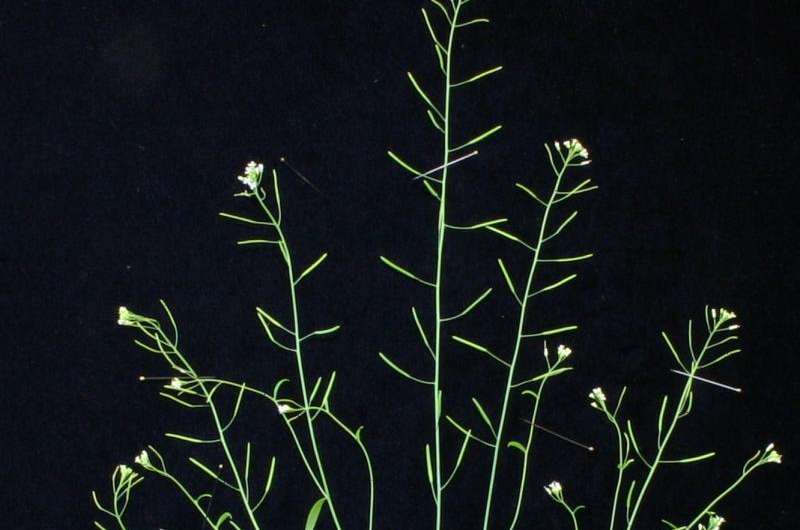Study discovers abscisic acid role in plant branching

An old chemical in plants is now being recognized with a new duty – inhibiting branch growth to react to weather or end use – thanks to a recent Texas A&M AgriLife Research study.
Dr. Scott Finlayson, AgriLife Research molecular physiologist in the Texas A&M University soil and crop science department at College Station, has been studying branching of plants for several years.
Shoot branches in plants are produced from buds present where the leaf meets the stem, Finlayson said. The growth of these buds is regulated by chemicals known as phytohormones, which are produced by the plant and have similarities to hormones found in animals.
The most intensely studied phytohormone is auxin, even as far back as the 1800s, he said. Many scientists believe auxin is the most important factor controlling branching.
However, Finlayson and former student Dr. Srinidhi Holalu, now a post-doctorate research associate at the University of California-Berkeley, recently discovered there is more than one hormone affecting the branching process.
Their work was recently published and spotlighted in the Journal of Experimental Botany as breaking new ground.
The paper, titled "The ratio of red light to far red light alters Arabidopsis axillary bud growth and abscisic acid signaling before stem auxin changes," received attention as being at the forefront of putting the new hormone into the branching picture, he said.
"Our lab and others have recently shown that another phytohormone called abscisic acid, or ABA as it is known, also plays an important role," Finlayson said.
ABA was identified in the 1960s and it was suggested then it might play a role in branching, but the ability to test it genetically was not available, he said. ABA is known more for its role in regulating water movement through the plant.
"We found the genetic tools to show it is also a regulator of branching and were the first to report on it," Finlayson said.
Branching is an important plant feature, he explained, and is controlled by light signals modified by neighboring plants. If the branches are inhibited, the stem will grow taller. The plant invests in the main shoot rather than in branching, to get to more direct light.
"When plants have lots of room to grow, they tend to branch a lot," Finlayson said. "However, when plants are crowded, like in a field of crops, the light signals produced tell the plants to branch less."

He said their research was conducted in Arabidopsis, a model plant in the mustard family that is neither good to eat nor valuable other than for its genetics. However, these results may be extended to important crop species.
For instance, he said, they also study the sorghum plant and fewer branches, or tillers, are desirable when growing for grain. But if it is grown for feed, more branches and tillers are wanted.
"So this is something that might be tweaked depending on the end use," Finlayson said.
A greater use for this information may be found in the horticulture industry rather than the row crop industry, he said.
"It could be used to regulate the growth of high-value crops such as almonds," Finlayson said. "If the buds begin growth too early, they could be subjected to freeze. ABA is such that it can be sprayed on and will wear off in a short time, allowing a producer to move the production time to meet weather conditions."
Holalu explained their study examined the mechanisms used by plants to control branching in crowded and uncrowded conditions.
"We investigated how auxin and ABA control whether buds form branches when given light signals that mimic crowded and uncrowded conditions," he said. "We found bud growth is altered very quickly, within six hours, when light signals are changed. We also found these changes in bud growth were more closely related to changes in ABA than auxin."
ABA, an inhibitor, is one of the earliest regulators of branching. Auxin regulates from the stem, but ABA is present in the bud and is probably responding more directly to light signals it is receiving, Holalu said.
"In our case, we used red to far red light signals to trick the plants to think they were in a crowded environment, and then crowding was reduced to start the branch growth again," he said.
The ABA levels and signaling were altered before bud growth changed, Holalu explained. Auxin levels and signaling, on the other hand, were only slightly affected later. Other experiments showed while auxin is a strong regulator of branching, it takes about a day for its effects to become apparent.
Finlayson said ABA seems to be involved very early and acts directly in the bud itself, while auxin has a stronger effect but acts much later in the stem.
"Both of these phytohormones, and others, are needed for appropriate branching to occur," he said.
More information: Srinidhi V. Holalu et al. The ratio of red light to far red light altersaxillary bud growth and abscisic acid signalling before stem auxin changes, Journal of Experimental Botany (2017). DOI: 10.1093/jxb/erw479
Provided by Texas A&M University



















